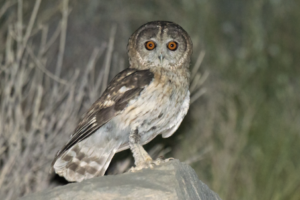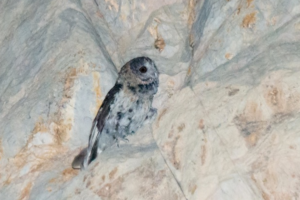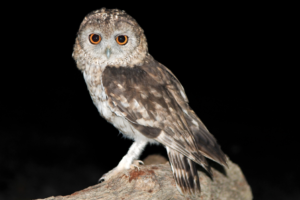Note that in the below article, Omani Owl is referred to as Strix omanensis (now Strix butleri) and Hume’s Owl is referred to as Strix butleri (now Strix hadorami).
When René and I went to northern Oman in March 2013, my modest goal was to improve our understanding of Pallid Scops Owl Otus brucei, and René’s was to photograph them. The Al Hajar range has many Pallid Scops and most of its wadis are very quiet, so it seemed the obvious place to try. I felt certain that with enough patience we would both meet our goals.
Towards the end of our first night we found a pair of Pallid Scops Owls hooting in a deep, flat-bottomed wadi with precipitous scree slopes and enormous sheer cliffs on either side. There was very little vegetation anywhere, least of all between the rounded pebbles and boulders of the wadi floor. Only a few well-spaced, gnarled Elb Trees Ziziphus spina-cristi seemed capable of withstanding the flash floods that periodically wipe the wadi clean.
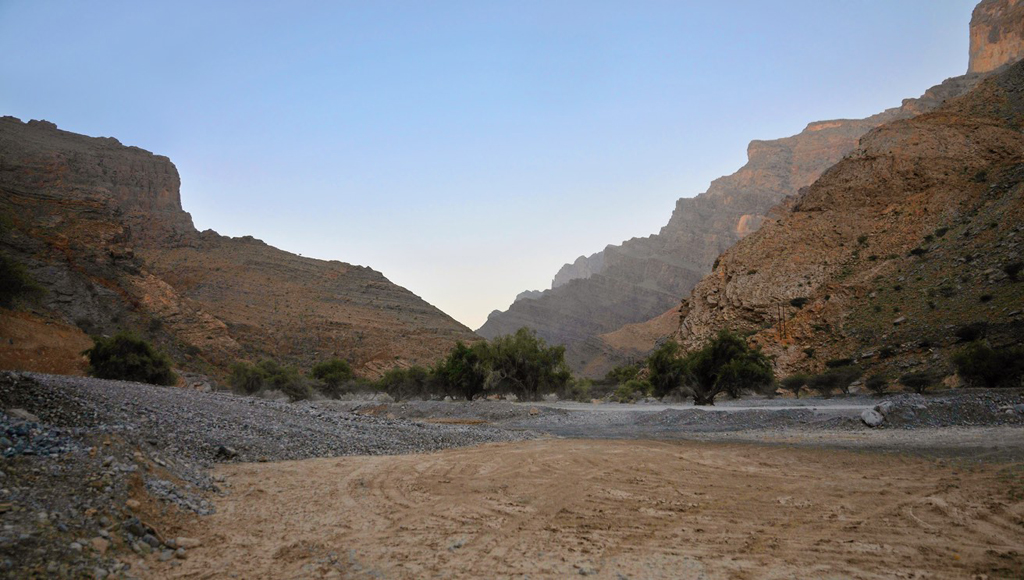
Habitat of Pallid Scops Owl Otus brucei and Omani Owl Strix omanensis, Al Jabal Al Akhdar, Al Hajar mountains, Oman, 20 March 2013 (René Pop)
Becoming intimate with Pallid Scops Owl proved to be a serious challenge. It was pointless to chase them. The noise of my feet kicking pebbles would always push them further, however quietly I walked. So every night I tried to anticipate where the pair would hoot and leave equipment recording there. Usually I was wrong. Two trees out could mean a distance of 50 m or more, too far for a usable recording. There were about 40 trees in the territory, so sooner or later I would get lucky.
By the fifth night I knew some trees the pair had visited at least twice, and put my equipment in a magnificent specimen on the border with the next territory. Then I sought out a comfortable boulder some distance away and listened. Things finally started to go my way. Not one but two male Pallid Scops Owls began to hoot in nearby trees on either side of the microphones. After they moved away I went in to check the recording. As I put on my headphones I noticed an unfamiliar owl-like hooting in the distance. Pressing ‘record’, I tried to ignore the large bats picking fruit in the foreground and listened for more clues (CD4-57).
CD4-57: Omani Owl Strix omanensis Al Jabal Al Akhdar, Al Hajar mountains, Oman, 00:19, 24 March 2013. The moment Omani Owl was discovered. A male, probably the live type specimen, is giving compound hoots on the right. Background: wingbeats of Egyptian Fruit-eating Bats Rousettus aegyptiacus with coughing and footsteps of goats. 130324.MR.001917.02
A few minutes later the owl, if that was what it was, changed to a pulsed kind of hooting, and there was a nasal, rising answer from the other side of the wadi. CD4-58 starts with some four-note hoots and heavy wingbeats of a bat, then a Pallid Scops Owl hoots from 0:05. The mystery owl’s pulsed hooting begins at 0:10 and the rising reply comes at 0:17. The distant bleating at 0:24 proved to be just a goat
CD4-58: Omani Owl Strix omanensis Al Jabal Al Akhdar, Al Hajar mountains, Oman, 00:26, 24 March 2013. Continuation of the discovery. Pulsed hooting of a male on the right, and soliciting call of a presumed female on the left. Background: Pallid Scops Owl Otus brucei, wingbeats of Egyptian Fruit-eating Bats Rousettus aegyptiacus, and goats. 130324.MR.002616.12
I was incredibly lucky to hear three different call types of the mystery owl within a few minutes. Triangulation led me swiftly to an exciting possibility, although I hardly dared to believe it. The four-note hoot was compound hooting, the pulsed hooting was just that, and the rising call sounded like a female soliciting call. This had to be a Strix owl, but not Hume’s S butleri, the only one known to occur in Arabia. Perhaps it was some Asian owl new to the peninsula, or even a species still unknown to science.
A few nights later I heard the owl again, this time with René as my witness, but it was to be a month before anyone saw it. That was when Arnoud and I returned to Oman on a mission to learn more. By now we knew that it sounded like no other owl, from Asia or anywhere else, but we still hadn’t seen it. For five nights we listened at the same place but heard nothing, despite the occasional use of playback. Our luck finally improved when we lured another one at a second site a few kilometres to the south. It was recorded and we even saw something Strix-like in the light of a powerful torch, 40 m from where we were standing, but it flew off too quickly for a photo. By the end of the trip my frustration was almost overpowering. I felt certain that we were dealing with a new species, but still knew almost nothing about its appearance, and had learned virtually nothing new about its sounds. I prepared myself for very slow progress.
Another month on, I reluctantly stayed to work on this book while Arnoud and Cecilia went back to the wadi. We expected that by May the owls would be even more difficult to detect. To my surprise, they turned out to be much more vocal than before. Arnoud even discovered a third territory in between the other two. Failing to lure any owl down to the road with playback, he realised that he would have to go up the scree to the base of one of the cliffs. For this he chose the original March territory. Cecilia would stay down at the car and they agreed a system of laser pen signals. Two strokes of light meant, “Playback please,” and more than 10 meant, “Get help I’ve fallen.”
Steep slopes were not the only inconvenience; the temperature was 44˚C when Arnoud started his climb. Anyone who has seen him in action will know how much photographic and sound recording gear he was carrying. There was traffic in the wadi for much of the evening, so his first two flashes came only around 22:00. No owl responded to Cecilia’s playback. The next time, at 23:00, a male responded from a great distance. Finally, Arnoud thought of using some small speakers to play compound hooting from the April territory. The March male responded immediately, coming gradually closer. Arnoud searched for it on the cliff. At first he saw what appeared to be a black goat, but then he noticed eyes in its ‘tail’. Four times it landed close to him on a rock, flying off as soon as he switched on the powerful torch that he needs for photographs.
On subsequent nights the owl gradually relaxed. Cecilia came up the slope to help with the torch, allowing Arnoud to focus his camera more easily. One of their photographs of this individual became our holotype. In the meantime, a series of close encounters allowed him to make much clearer recordings than we had managed in March or April. CD4-59 is our closest of compound hooting to date. All of the strophes contain four notes, and the rhythm is the same as in Richard Wagner’s famous wedding march Treulich geführt, better known in English as Here comes the bride.
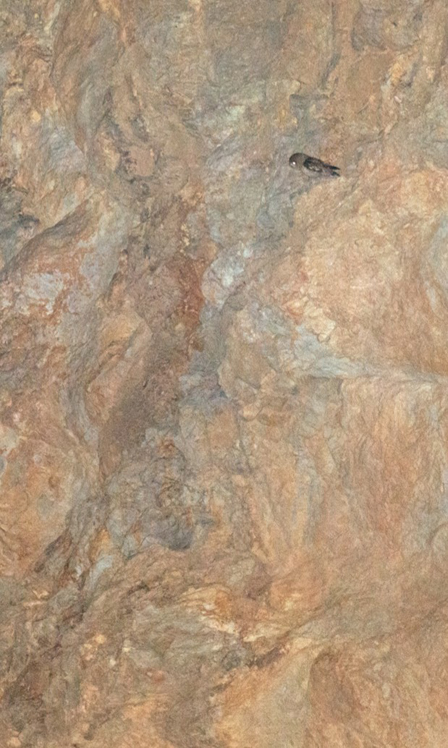
Omani Owl Strix omanensis, male, Al Jabal Al Akhdar, Al Hajar mountains, Oman, 26 May 2013 (Arnoud B van den Berg). Singing from huge cliff. Same as in CD4-59, 62, 63, 69 & 70, and probably also CD4-57 & 58.
CD4-59: Omani Owl Strix omanensis Al Jabal Al Akhdar, Al Hajar mountains, Oman, 23:32, 27 May 2013. Compound hooting of a male, almost certainly the type specimen, although Arnoud did not photograph during this particular session. 130527.AB.233200.12
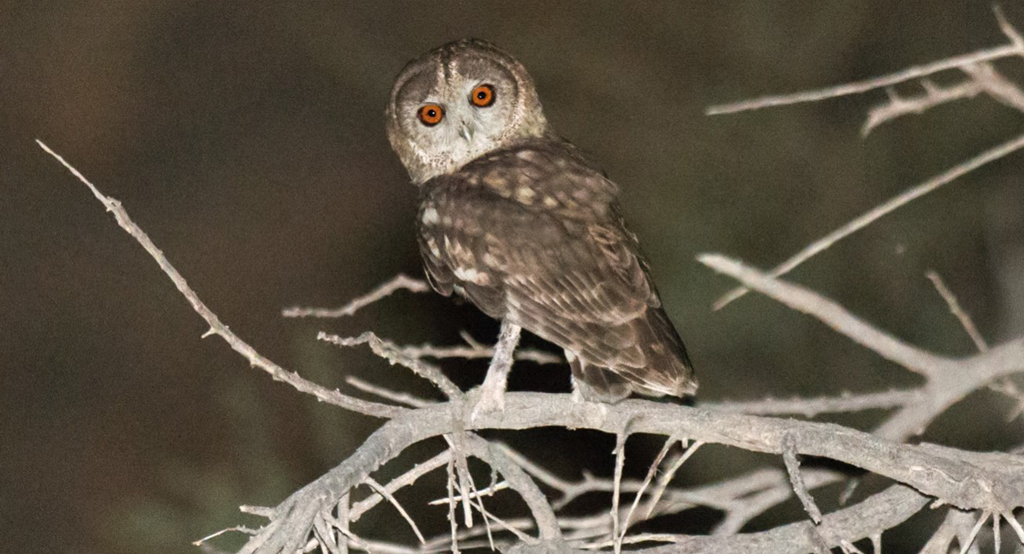
Omani Owl Strix omanensis, male, Al Jabal Al Akhdar, Al Hajar mountains, Oman, 24 May 2013 (Arnoud B van den Berg). Identical to holotype or type specimen and same bird as in CD4-59, 62, 63, 69 & 70, and probably also CD4-57 & 58.
At the time of writing more than a year has passed since the discovery. In October 2013 we presented Omani Owl Strix omanensis to the ornithological community (Robb et al 2013), and the news received widespread attention in the mainstream media. We have now devoted seven Sound Approach trips to the owl. A few pioneering birders have already added it to their lists, but the discovery is still very much in progress.
We have now recorded compound hooting from nine individuals and we know that its four-note rhythm varies only very slightly. In 2013 we also recorded five to seven-note hoots from two individuals in among the usual four-note hoots. One of them features in CD4-60, recorded during our first ever sighting. With hindsight, both were responding to playback or a human imitation, so this was an excited, more aggressive version of their compound hoot. In February 2014, we hardly provoked the owls at all, to learn as much as possible about their natural behaviour. Just one of four hooting individuals gave a five-note hoot during that trip, and that was immediately before copulation (cf, CD4-66).
CD4-60: Omani Owl Strix omanensis Al Jabal Al Akhdar, Al Hajar mountains, Oman, 00:27, 28 April 2013. Compound hooting of a hoarse-sounding individual, which I now believe to have been a male. This was the first Omani Owl that we ever saw. It gives five-note hoots at 0:23 and 0:35. Background: domestic goat. 130428. AB.002745.42
From the moment post-migration blues set in, late in the autumn of 2013, I was itching to get back to the Al Hajar mountains. I was determined not to miss the courtship period when the owls would be more vocal and perhaps use call types we had not yet heard. We assumed that courtship would take place in the first two months of the year. Eventually Mark, Mo, Killian and I flew to Oman on 13 February. Several other people had been searching for Omani Owls in the weeks before. Most had gone to the type locality, but a few pioneers had tried to find new pairs. Immediately before our trip, John McLoughlin (aka ‘Johnny Mac’) had been searching by himself, while Mike Watson of Birdquest had led a specially organised Omani Owl expedition. Our friend Ian Lewis was one of the participants.
One afternoon Johnny Mac stood on the roof of a large building in the centre of a small nearby town and had a good look at the surrounding landscape. He saw one wadi with good habitat and an access road, and decided to give it a go that evening. On 4 February that was where he heard a new pair, some 20 km from the type locality. The Birdquest group followed this up, seeing a pair just before the end of the following night. At the crack of dawn three mornings later, both parties saw the male and female disappearing into separate holes in the same section of cliff. On the eve of our trip, this was excellent news.
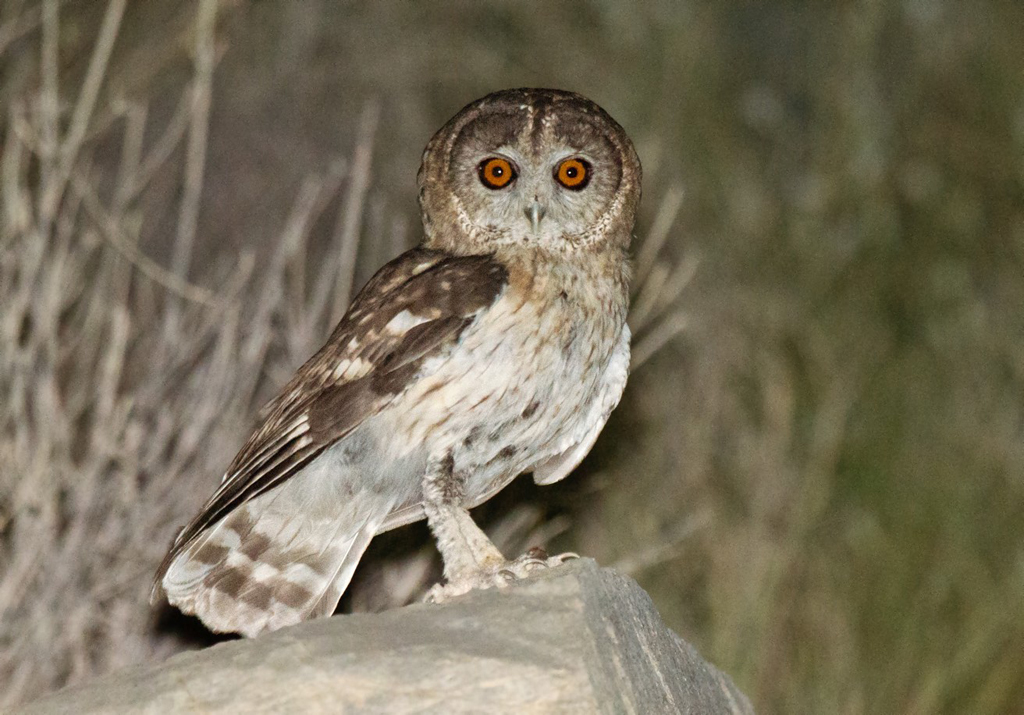
Omani Owl Strix omanensis, male, Al Jabal Al Akhdar, Al Hajar mountains, Oman, 26 May 2013 (Arnoud B van den Berg). Same as in CD4-59, 62, 63, 69 & 70, and probably also CD4-57 & 58.
The male of the JM (‘Johnny Mac’) pair turned out to be the lowest-pitched Omani Owl that we have recorded so far. Sometimes his hooting was a little hoarse; at other times it was perfectly clear. We also heard the female hooting almost every night during our February trip. In CD4-61, both are hooting at close range. The female’s compound hooting was hoarser and much higher-pitched than the male’s. The lowest note of her hoot was the second, not the first as in the male. These male-female differences were consistent for this pair, but we still need to find out whether they apply to all Omani Owls. At any rate, my previous speculation that male compound hooting was higher-pitched than that of females (Robb et al 2013) was proven wrong.
CD1-61: Omani Owl Strix omanensis ‘Wadi Mac’, Al Jabal Al Akhdar, Al Hajar mountains, Oman, 05:59, 17 February 2014. Compound hooting of male and female, with pulsed hooting of male towards the end. Background: pulsed hooting of a distant male Omani Owl (from 1:11), Sand Partridge Ammoperdix heyi and Hume’s Wheatear Oenanthe albonigra. 140217.MR.055904.01
Towards the end of CD4-61, the male started pulsed hooting, perhaps in response to a distant rival doing the same. As in other Strix owls, the use of this sound changes according to context. When confronting rivals, including ones simulated with playback, males give pulsed hooting in fairly loud, well-ordered sequences. When interacting with females, however, males often just give a brief burst directly after a compound hoot.
CD4-62 is a sequence of pulsed hooting that had been stimulated by playback, and in this case the caller is the living type specimen. CD4-63 is taken from later in the same recording. It shows how pulsed and compound hooting are sometimes mixed together in variable patterns when responding to playback or rivals. This recalls the way that the two male Hume’s Owls also mixed their equivalent sounds in a territorial conflict (cf, CD4-46).
CD4-62: Omani Owl Strix omanensis Al Jabal Al Akhdar, Al Hajar mountains, Oman, 00:30, 28 May 2013. Pulsed hooting of a male, the same individual that served as a live type specimen. Background: probable begging calls of a juvenile, eg at 0:37, 0:59, 1:03, 1:13 and 1:31. 130528.AB.003000.02
CD4-63: Omani Owl Strix omanensis Al Jabal Al Akhdar, Al Hajar mountains, Oman, after 00:30, 28 May 2013. Mixed pulsed and compound hooting of a male, the same individual that served as a living type specimen. Background: probable begging calls of a juvenile, very faint. 130528.AB.003000.02
CD4-64: Omani Owl Strix omanensis ‘Wadi Mac’, Al Jabal Al Akhdar, Al Hajar mountains, Oman, 18:37, 15 February 2014. Pulsed hooting of a female. After the first 10 seconds, the gap to the next series has been shortened. 140215.MR.183717.22
Both sexes give pulsed hooting, and the evidence from the JM pair is that the female’s pulsed hooting is considerably higher-pitched (CD4-64). During our February 2014 trip she made this sound only three times. Every time, the rhythm was untidy and her strophes had an overall descending shape.
During our six-night visit in February 2014, the JM pair were courting. We often heard and saw what appeared to be courtship feeding. A couple of compound hoots of one individual would be followed by a long series of rising, nasal calls of the other. I have no doubt that just as in other Strix owls, the male was announcing his arrival with compound hoots and the female was responding with soliciting calls. CD4-65 is a typical example of such a food pass. The JM female was far less mobile than her mate, and her soliciting calls usually came from the same spot on the cliff. They were the first sound that we heard at the end of the day, and the last to cease in the morning.
CD4-65: Omani Owl Strix omanensis ‘Wadi Mac’, Al Jabal Al Akhdar, Al Hajar mountains, Oman, 06:04, 15 February 2014. Courtship feeding: female soliciting calls with male compound hooting. Background: Sand Partridge Ammoperdix heyi and Hume’s Wheatear Oenanthe albonigra. 140215.MR.060430.22
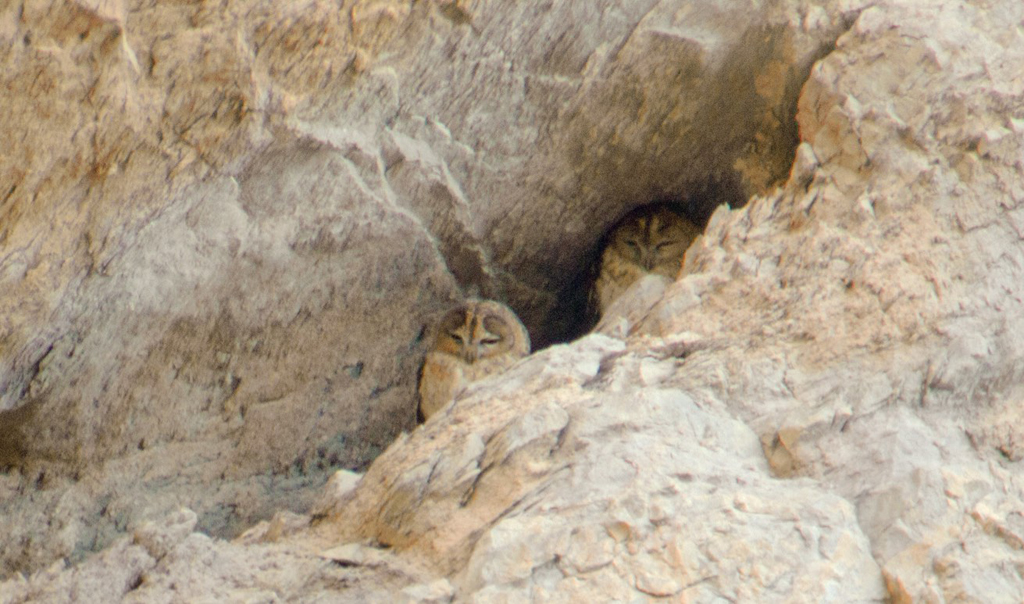
Omani Owls Strix omanensis, male and female, ‘Wadi Mac’, Al Jabal Al Akhdar, Al Hajar mountains, Oman, 17 February 2014 (Killian Mullarney). Same as in CD4-64 to 66. The male (left), which we only ever saw from a distance, had a more poorly defined breast band than the female but a much more striking face. His ‘dark eyebrows’ were even more striking than in the holotype, with a very clear outline. Their shape and position were reminiscent of the base of a ram’s horns. Both individuals kept their facial disk partly folded by day.
Females use soliciting calls not only to demand food. At 05:59 on 14 February, the male gave one compound hoot and the female replied with soliciting calls from her roost. She continued for around 20 minutes. In the first light of dawn, I saw the male approaching the cliff. Together the pair flew to a prominent rock about 40 m from their roosts, where I could see them silhouetted against the sky. At one point they fluttered like butterflies above the edge of the cliff. They struck me as very broad-winged. When they settled on the rock again, I saw the male mount the female with flapping wings.
On another occasion I was recording when the owls moved to the same rock, this time in complete darkness. CD4-66 starts with the female already there and the male compound hooting near the roost holes. By 0:17 he has flown left to join the female. From 0:34 the female’s soliciting calls become lower-pitched and more urgent. The chittering at 0:39 suggests copulation (cf Tawny Owl Strix aluco: CD4-24).
CD4-66: Omani Owl Strix omanensis ‘Wadi Mac’, Al Jabal Al Akhdar, Al Hajar mountains, Oman, 21:19, 14 February 2014. Probable copulation, not confirmed visually. Starts with compound hooting of male on right, and soliciting calls of female on left. Male flies left to join female, continuing his compound hooting. There is a 5 note compound hoot at 0:17 (the first note is doubled). Background: wingbeats of Egyptian Fruit-eating Bat Rousettus aegyptiacus. 140214.MR.211905.22
Every night started and ended with the owls about 10-15 m apart in their respective holes on the cliff. The male’s hole was sausage-shaped and angled at about 45˚, with room for two in the entrance. The female’s hole looked much smaller but may have led to a deeper chamber. Sometimes she sat with the male at his place before going to hers. One morning she seemed to stay with him for the day, but when we returned in the evening she emerged from her usual roost.
When Arnoud and Cecilia returned to Oman in late April 2014, I had little doubt that they would find the owls using one of these holes as a nest. During many nights at the spot, however, Arnoud could detect no activity at all. The JM pair remained completely silent. Had they abandoned their breeding attempt, moved elsewhere, or were they simply being incredibly secretive? I returned alone in late May, hoping that the pair had somehow evaded detection. If they had nested elsewhere on the cliff, by late May their young would surely be calling loudly enough for me to know. After a couple of nights without success, even resorting to playback, I had to conclude that Arnoud had been right: the pair had disappeared. The Pallid Scops Owls were very quiet in this wadi, so I wondered if there was a lack of food. I also worried that collectors had somehow got wind of this pair and shot them. Either way, if I was going to record any young Omani Owls, I would have to find them elsewhere.
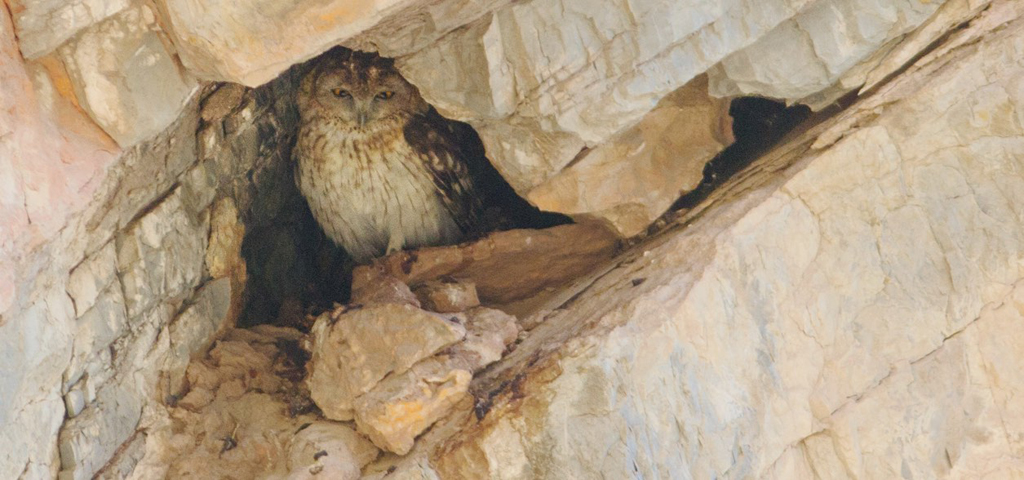
Omani Owl Strix omanensis, female, ‘Wadi Mac’, Al Jabal Al Akhdar, Al Hajar mountains, Oman, 15 February 2014 (Killian Mullarney). Same as in CD4-61 & CD4-64 to 66. In the shadows of a brightly lit morning, the female showed much warmer colours than the holotype Arnoud had photographed at night. We were struck by how Tawny Owl S aluco-like the saturated browns in her plumage made her appear. When she spread the disk, the upper part appeared darker, although she did not have such well-marked ‘eyebrows’ as the holotype or her mate. One feature that stood out from a distance was a darkish band on her upper breast, which we also noted during our first sighting in April 2013. The dark vertical streaks on the female’s breast were every bit as strongly marked as in the holotype.
For several nights I visited all the Omani Owl territories I knew and listened for any sound that might be from a juvenile. I assumed that their begging calls would be shaped like soliciting calls of adults, but have a much more hissing timbre. From time to time I heard calls that seemed about right, but most were foxes Vulpes or leaf-toed geckos Asaccus. I was only convinced once, after imitating male compound hooting in a territory I knew to be occupied. No owl had been calling, but immediately after my imitation I heard soliciting calls of a female and begging calls of up to two juveniles. The distance was about 600 m, so the recordings are dreadful. CD4-67 is a juvenile on its own, while CD4-68 is a juvenile with the female and a male Pallid Scops Owl. The begging calls continued for some time, and sometimes had a slightly descending inflection. Attempts to climb closer proved fruitless. Still, a poor recording is better than nothing. Having learned how juveniles sound, I was able to recognise them in the background of some of Arnoud’s recordings from 2013 (eg, CD4-63, CD4-64 & CD4-70).
I never got close enough to any juveniles for their mother to use guarding calls or ‘alarm calls’, although I am sure that Omani Owl will have such a call in its repertoire. Another call type that we did record is so similar to how I would expect guarding calls to sound that for a while that’s what I assumed it was. However, since we only ever heard it immediately after playback or imitations of hooting, it must be territorial. CD4-69 illustrates this ‘distance call’ in flight, and in CD4-70 the individual barks are grouped into much shorter strophes.
CD4-67: Omani Owl Strix omanensis Al Jabal Al Akhdar, Al Hajar mountains, Oman, 01:28, 29 May 2014. Faint begging calls of a juvenile at 600 m distance. Listen for a rising, fairly high-pitched sound with a hissing timbre at 0:01, 0:04 and 0:07. A similar but lower-pitched sound at 0:05 may belong to a much closer leaf-toed gecko Asaccus. 140529. MR.012824.12
CD4-69: Omani Owl Strix omanensis Al Jabal Al Akhdar, Al Hajar mountains, Oman, 00:30, 28 May 2013. Distance call series in flight, then compound hooting, a reaction to playback (not included). Background: rising, nasal call of leaf-toed gecko Asaccus sp. 130528.AB.003000.12
CD4-68: Omani Owl Strix omanensis Al Jabal Al Akhdar, Al Hajar mountains, Oman, 01:11, 29 May 2014. Begging calls of a juvenile and soliciting calls of a female at 600 m distance, with continuous hooting of a male Pallid Scops Owl Otus brucei. The juvenile is easiest to hear at 0:00, 0:03, 0:10 and 0:13 and the female at 0:06 and 0:12. There may be a second juvenile in the background. 140529.MR.011116.32
CD4-70: Omani Owl Strix omanensis Al Jabal Al Akhdar, Al Hajar mountains, Oman, 00:55, 28 May 2013. Three series of distance calls after playback (not included). Background: presumed juvenile begging calls, best from 0:55, and Dhofar Toad Bufo dhufarensis. 130528.AB.005500.12
On an owling trip like ours in February 2014, it can be difficult to find a sensible daily rhythm. Exhaustion threatens to strike but adrenaline keeps it at bay. Sometimes we stayed out all night. Other nights we returned to the hotel for a few hours of sleep, with varying success. One time we returned mid-evening and agreed to go out at again 04:00. I managed to sleep but Killian stayed awake. When he returned from photographing a Pallid Scops Owl just outside our room at 00:30, I woke up. My thoughts turned to the owls and soon I was driving to the wadi. I decided to leave recording equipment at three different places to find
out whether the JM pair had any neighbours. Having done so, I was heading back through the wadi to go and fetch the others when an Omani Owl flew across the track right in front of me.
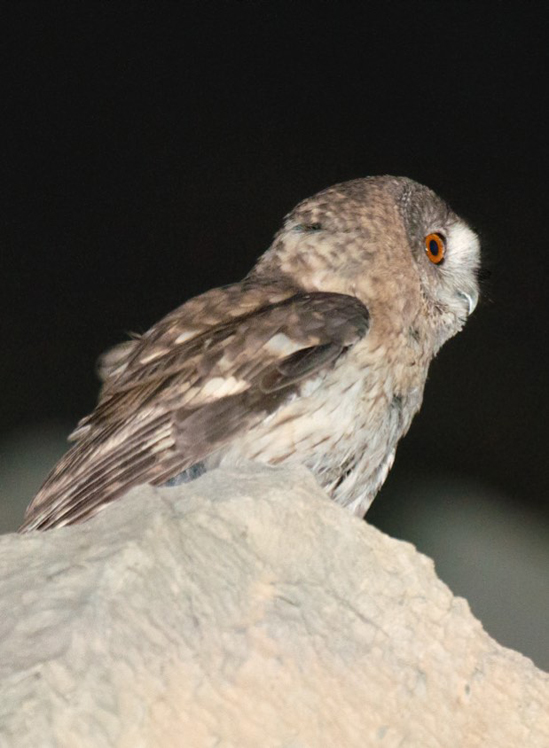
Omani Owl Strix omanensis, male, Al Jabal Al Akhdar, Al Hajar mountains, Oman, 26 May 2013 (Arnoud B van den Berg). Same as in CD4-59, 62, 63, 69 & 70, and probably also CD4-57 & 58.
With my torch I found it only about 10 m from the car, perched on a large rock just left of the track with its back towards me. I noticed two broad tail bars and when it looked over its shoulder I saw its orange eyes. The facial disk was fully open and it had prominent dark ‘eyebrows’. When it turned sideways, I noticed the marbled pattern on the side of its head. After about 20 sec it flew off up the slope and landed on a cliff near another individual, its mate. Both were standing sideways on the steeply angled rock face, one leg fully stretched and the other one held short due to the height difference. Their attention was focused on the rock just in front of them, and they pounced every now and then. I could not see what they were hunting, but it must have been tiny. When one of them flew, my torch lit up its underside. The dark wingtip and broad trailing edge contrasted strongly with the whitish interior of the underwing.
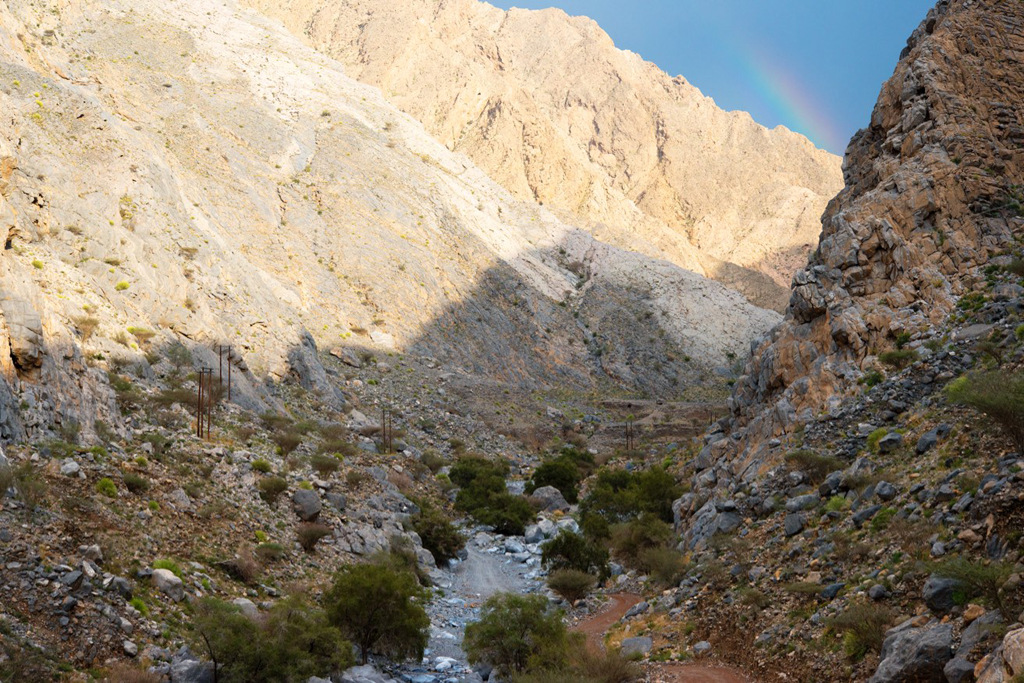
Habitat of Omani Owl Strix omanensis, Al Jabal Al Akhdar, Al Hajar mountains, Oman, 23 April 2014 (Arnoud B van den Berg)
For the meantime, the known population of Omani Owl numbers only around 15 individuals. The total number of territories detected in 2013-14 stands at seven, located in the two wadis we have worked in, some 20 km apart. There is also a third wadi, where Pieter van Eijk heard an unexplained owl sound while camping in February 2008. At the time he thought it must be a Hume’s Owl, until he heard recordings of that species and learned that in Oman it only breeds in the south. Five years later when Pieter heard recordings of Omani Owl, the mystery was finally solved (van Eijk 2013). His campsite was some 33 km from the discovery site, and all three wadis are within 54 km of one another.
Now that we have a better idea of Omani Owl breeding phenology, BirdLife International is seeking Omani collaboration for a wider survey. Does it occupy the whole of the Al Hajar range, or is it restricted to the central part where we have observed it? Does it go all the way to the highest peaks, up to 2980 m, or is it just in the 380-700 m range where we have heard it? Our experience suggest that February would be the best time to find out, with the owls calling every dusk and dawn at the very least.
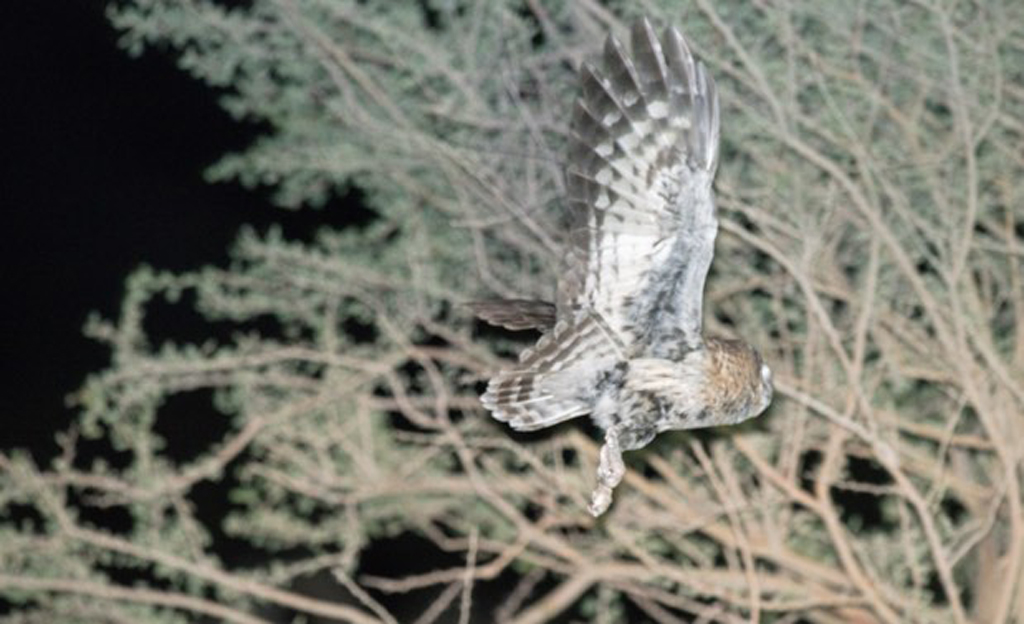
Omani Owl Strix omanensis, male, Al Jabal Al Akhdar, Al Hajar mountains, Oman, 26 May 2013 (Arnoud B van den Berg)
I wonder if there are still important Strix populations in the wider region waiting to be discovered. Might there be butleri in Iran or Pakistan after all, or an undiscovered owl in some remote mountain range in the Sahara? Rumours of a Strix owl on the island of Socotra about 380 km south of Yemen have circulated for over a century (Jennings 2010), but the task of confirming them is still up for grabs.
When I started work on this book, I hoped to discover which owls could be identified according to their sounds, regardless of their official taxonomic rank. I also hoped to learn new ways to sex and age owls by their sounds, and to understand more of what they were up to in the dark. Then in 2009, Arnoud rediscovered fish owls in Turkey and recorded sounds that showed they were a separate species. Enough reasons to come up with a title like Undiscovered owls, which first appeared in my notebook a year before my first encounter with Omani Owl.
The title takes its inspiration from Carl Jung’s The Undiscovered Self (1957). Mankind can only be saved from collective madness, writes Jung, if each of us discovers our true self. Owls help me to find mine. To listen to them, I step outside my routine and look for wild places where the world feels more authentic. Escaping from noise allows quiet thoughts and intuitions to be heard. Being in the dark liberates my mind from visual-only reality. When I am owling, anything seems possible.
On 24 March 2013, serendipity was on my side. Having studied the sounds of all the other owls of the Western Palearctic, I quickly recognised Omani Owl as something new. I may never have such good luck again, but the experience taught me that anything is possible.
What else might we discover lurking just beyond the horizon that separates mind from silence, if only we learn to listen more like owls?
…and finally
In the 1980s many birders experienced their first Hume’s Owl Strix butleri in Israel alongside Hadoram Shirihai. Hadoram’s exclusive site was guarded by a member of the Israeli military, who kindly let birders look at the owls through a night vision scope.
Hadoram had appeared dramatically on the birding scene selling what became known as ‘the Hadoram experience’. At the time, Peter Grant and Killian Mullarney were running Sunbirder trips to Eilat, a concept where a group of 60 or more birders stayed in the same place and could choose either to go birding independently or to take organised daily tours. At night everyone attended a log call. The Hadoram experience involved two or three exhilarating days driving madly through the Negev desert, finding birds like MacQueen’s Bustard Chlamydotis macqueenii and Saker Falcon Falco cherrug.
One evening Hadoram arrived at the log with his latest crew of wild-eyed companions, just as Peter was starting the log. Hadoram strode up the central aisle carrying a cloth bag. He reached inside and pulled out a squawking black gamebird, demanding that Peter identify it. As half the room ticked Black Francolin Francolinus francolinus, Peter laughed and identified it as a chicken. Evidently, Hadoram had ‘borrowed it’ from the pets’ corner of a local kibbutz and tethered it in an attempt to lure a Saker for his group.
In the intervening 30 years, Hadoram wrote the scholarly Birds of Israel (Shirihai et al 1996) and became better known for photographing the world’s rarest petrels. A few years ago, he became the first person to discover where the legendary Zino’s Petrel Pterodroma madeira could be observed regularly at sea. Hadoram sometimes visits Britain in order to examine bird skins held in The Natural History Museum at Tring. In excitement over one collection of albatross remains, he and a member of staff nearly pushed the cabinet through a wall, to the amazement of other researchers who could hear the noise in adjacent rooms.
Coming right up to date, a group of Hadoram’s colleagues have been rocking the cabinets again. Stimulated by our discovery of the Omani Owl S omanensis, they re-examined the shabby old type specimen of Strix butleri from Ormara in southern Pakistan (Hume 1878). When they compared its DNA with that of other Hume’s Owls, they found a surprisingly large difference. They went on to describe more subtle differences in morphology. Kirwan et al (2015) believe that all Hume’s Owls other than the Pakistani type specimen may be assigned to a ‘new’ species. The name they propose for this, the bird everyone has been identifying as Hume’s, is Strix hadorami.
The oldest specimen of Hume’s Owl dates from 1864, when Claude Wilmott Wyatt shot an unidentified owl in Wadi Feiran, Sinai. Wyatt was a “very shy, reserved, and silent man” (Ibis 43: 347-348, 1901), and perhaps this is why he never named his owl. Fifteen years later, Tristram (1879) identified Wyatt’s specimen as Hume’s newly described butleri. For well over a century nobody questioned the link.
Kirwan et al’s conclusions will have surprised many, but how solid are they? The DNA part of their paper is based on a sequence of just 218 base pairs, the most important branches in their phylogenetic tree have no support, and DNA of Omani Owl has yet to be sequenced. The mystery of Hume’s type specimen is still unsolved, and sadly it no longer hoots. Pending further research, we use the names Hume’s Owl and Strix butleri according to their December 2014 meaning.
In the meantime, Hume’s original Strix butleri presents an opportunity. The number of skilled observers in Pakistan and especially Iran is growing fast, but there must be vast areas of habitat suitable for a cliff-dwelling owl that have yet to be explored. Night birding in particular could bring rich rewards. Beaman (1994) chose the headland just south of Ormara as the point where the Palearctic meets the Oriental region. The owl that Hume described in 1878 could still be lurking near this desert frontier, or elsewhere in south-western Asia, just waiting to be rediscovered. If it is, we’re itching to know how it sounds.
Names always keep people talking, and the ones we have used in this book will no doubt also provide fuel for the fire. In the end, though, what we choose to call our owls is far less interesting than the owls themselves. What matters most to us is how they call, and especially whether anyone is willing to listen.


